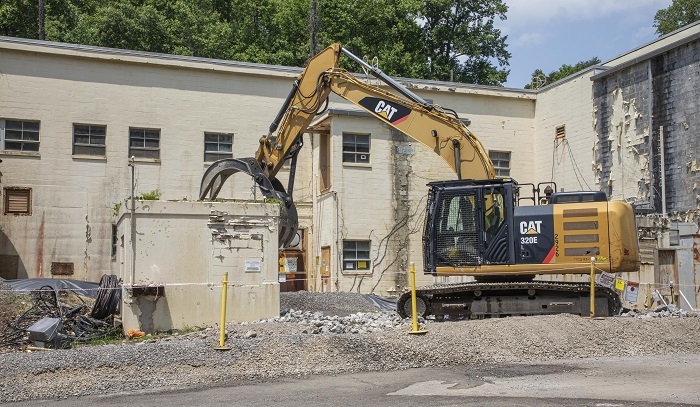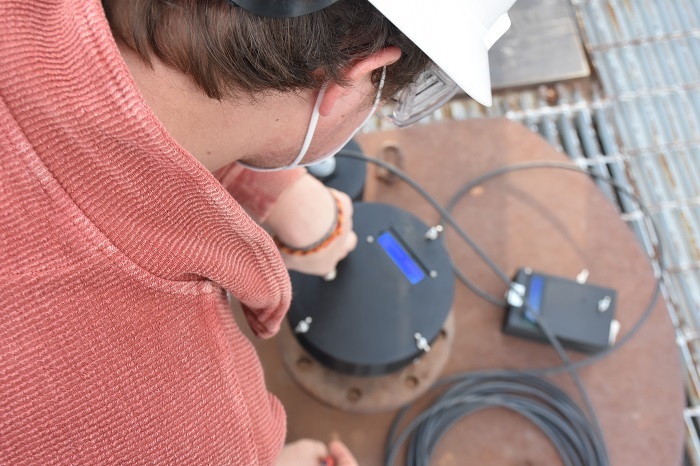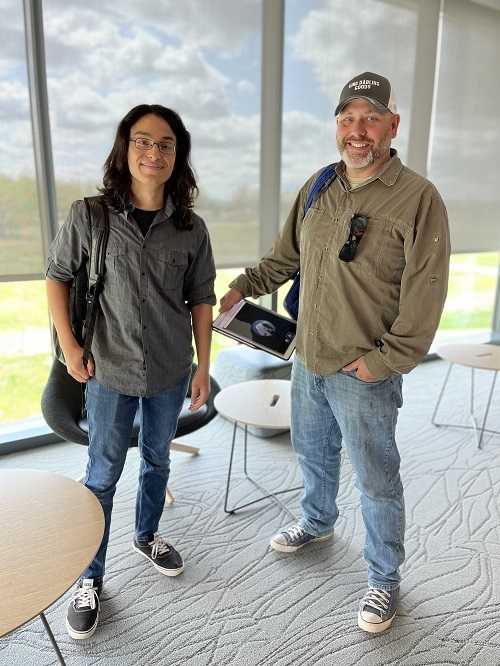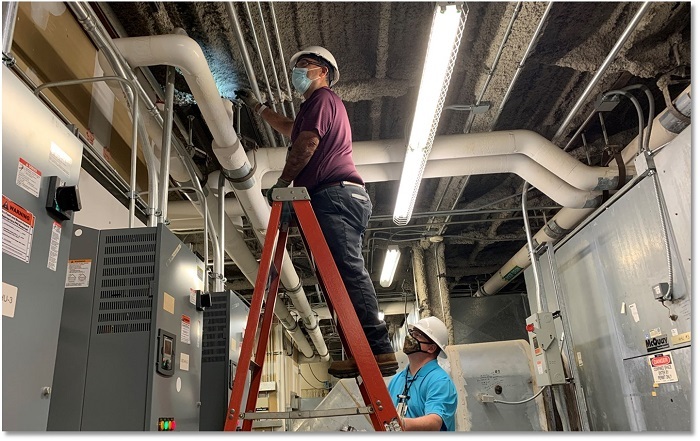 The Panther T16 sprays fixative with a high-pressure water cannon onto X-326 building debris at the Portsmouth Site. It can carry up to 2,700 gallons of water and fixative. The fixative, which normally dries clear, has been tinted green to mark areas that have already been sprayed.
PIKE COUNTY, Ohio – EM’s Portsmouth Site has been using a new tool as part of its dust-suppression systems at its X-326 process building demolition project.
The tracked Prinoth Panther T16 crawler carrier features a zero-degree turn radius and is able to adapt to irregular terrain. It traverses the demolition area daily, spraying fixative on building debris with an onboard Dust Demolisher and 2,700-gallon tank of fixative to lock down dust.
The Dust Demolisher is a high-pressure water cannon that delivers water and fixative up to 150 pounds per square inch with a 150-foot-plus throwing range on demand. It has a 30-to 330-degree rotation capability with 10-degree manual incremental range settings.
“The Panther and Dust Demolisher represents state-of-the-art mitigation tactics for dust suppression,” said Acting Portsmouth Site Lead Jeremy Davis with EM’s Portsmouth/Paducah Project Office. “They are part of a comprehensive strategy to protect workers and our neighbors from any potential hazards associated with cleanup activities.”
In addition to the Dust Demolisher, the demolition project has multiple other dust-suppression systems in place. More than 80 percent of the X-326 building has been demolished. Finishing the teardown of the half-mile-long building is one of EM's 2022 priorities.
Once demolition of the X-326 and debris removal are complete, the dust suppression systems will be moved to the next process building slated for demolition.
The X-326 is one of three massive process buildings originally built to enrich uranium at the Portsmouth Site.
 Crews began demolishing the Criticality Experiment Laboratory on the Oak Ridge Reservation by removing some of the auxiliary facilities surrounding the main building.
OAK RIDGE, Tenn. – EM crews started tearing down a 1940s-era facility this month at the Y-12 National Security Complex in the latest project to address a large inventory of high-risk excess contaminated facilities on the Oak Ridge Reservation.
EM contractor United Cleanup Oak Ridge (UCOR) is taking down the former Criticality Experiment Laboratory, also known as Building 9213, the first structure to reach the demolition stage at Y-12 since crews safely demolished the Biology Complex in 2021.
“This facility demolition is one of our immediate priorities at Y-12, and we are in the process of preparing numerous others for demolition,” said Laura Wilkerson, acting manager of DOE’s Oak Ridge Office of Environmental Management. “These projects are eliminating risks and clearing land that can support national security missions in the future.”
 A view of the deteriorated condition of the Criticality Experiment Laboratory on the Oak Ridge Reservation. Its demolition will eliminate a high-risk excess contaminated facility from the Y-12 National Security Complex footprint.
More than 50 percent of the facilities throughout the National Nuclear Security Administration complex, which includes Y-12, are more than 40 years old. The Criticality Experiment Laboratory is one of them.
Built in 1949, the two-story, 24,000-square-foot facility was used to conduct experiments with fissile uranium isotopes for nuclear reactor designs. Employees performed more than 9,700 experiments there in its first decade, and it later supported the Oak Ridge National Laboratory’s High Flux Isotope Reactor program. The building has been closed since 1992.
Crews brought the lab to the cold and dark stage — disconnection of all utilities to the facility —in 2021, along with several other Y-12 facilities.
“I am proud of what our workers have been able to safely accomplish at Y-12 under pandemic conditions and in a climate of supply chain shortages,” said UCOR President and CEO Ken Rueter. “In addition to starting demolition of this facility, our team demolished the last two buildings in the Biology Complex; fully deactivated the Old Steam Plant; and pressed forward with deactivating three former enrichment buildings that were part of the Manhattan Project.”
As part of deactivating the building, workers had safely removed, packaged and shipped 1,496 linear feet of asbestos-insulated piping, 323 linear feet of process piping and 8,540 square feet of other asbestos-containing material.
Demolition on the Criticality Experiment Laboratory is scheduled to be complete in fall 2022.
-Contributor: Susanne Dupes
 Anders Lind works on a tank integrity project at the Cold Test Facility near the Hanford Site as part of an internship project with Washington State University’s Tri-Cities campus and Hanford Site contractor Washington River Protection Solutions.
RICHLAND, Wash. – EM Office of River Protection (ORP) contractor Washington River Protection Solutions (WRPS) is developing innovative, collaborative ways to tap into the future workforce.
In addition to the annual group of summer interns from colleges around the country, up to 10 students from Washington State University’s (WSU) Tri-Cities campus will be selected for unique, year-long, paid internships. The students, who have junior, senior or graduate status during the next academic year, will receive full-time summer employment and continue working part time during the school year in their chosen fields. WRPS intends to offer full-time employment opportunities to successful interns when they graduate.
“This partnership with WSU Tri-Cities brings a whole new dynamic to workforce development,” said Wes Bryan, WRPS president and project manager. “This puts us on the right path to establishing the next generation of workforce that will advance our cleanup mission.”
As part of the partnership, WRPS donated $250,000 to WSU Tri-Cities to fund program costs.
 EM Office of River Protection tank operations contractor Washington River Protection Solutions (WRPS) presented a check to Washington State University (WSU) Tri-Cities to kick-start an internship cooperative. Pictured are, from left, Amy Schatz, WRPS WorkSource Resources director; John Eschenberg, outgoing WRPS president and CEO; Sandra Haynes, WSU Tri-Cities chancellor; Wes Bryan, WRPS president and project manager; and Anna Plemons, WSU Tri-Cities associate vice chancellor.
Recently, students at WSU Tri-Cities also worked with ORP contractors to develop a new logo for a committee that works to recruit disabled and veteran job candidates. Columbia Basin for an Accessible and Veteran-Friendly Workforce (CBAVFW) is a collaborative organization with a goal of helping disabled community members and veterans find employment. The collaboration includes human resources professionals from several Hanford Site contractors and subcontractors, Columbia Basin College, Pacific Northwest National Laboratory, WorkSource Columbia Basin and local veterans’ organizations.
When representatives from CBAVFW reached out to WSU Tri-Cities for help with branding, Anna Plemons, associate vice chancellor of academic and student affairs at WSU, suggested turning the request into a class project to give more than two dozen students the opportunity to work on a client-driven project.
 |
|
Washington State University Tri-Cities students Alejandro Castaneda, left, and U.S. Coast Guard veteran Scotlyn Dabling worked as a team to design the winning logo for the organization Columbia Basin for an Accessible and Veteran-Friendly Workforce. |
Students from a Digital Technology and Culture class at Washington State University Tri-Cities submitted conceptual designs for a logo for Columbia Basin for an Accessible and Veteran-Friendly Workforce. The winning logo was designed by Alejandro Castaneda and U.S. Coast Guard veteran Scotlyn Dabling. |
|
 |
“We presented this to a class of our Digital Technology and Culture (DTC) Program students who are learning to be culturally responsive in their approach to creative products, and this provided a perfect career-connected learning opportunity,” said Plemons. “This project was challenging for students because they wanted to respectfully represent military service and disability with inclusivity without being cliché.”
When they presented the project to the DTC class, CBAVFW representatives were unaware that several of the DTC students are military veterans. Plemons said the chosen logo was designed by a small group that included a U.S. Coast Guard veteran.
“These applied learning experiences provide an incredible opportunity for students to contribute to the overall EM mission of environmental cleanup and social justice as we work to connect protected workers with living-wage jobs,” said Mary Kruger, EM deputy assistant secretary for resource management.
-Contributor: Jenna Kochenauer
 Savannah River Nuclear Solutions Talent Management Specialist Anitra McManus assists computer science engineering major Kurt Abraham, a sophomore at Claflin College, during a virtual workshop developed to help students create resumes and prepare for interviews.
AIKEN, S.C. – An EM contractor at the Savannah River Site (SRS) has supported more than 200 students from eight Historically Black Colleges and Universities (HBCUs) throughout South Carolina since January 2020.
Savannah River Nuclear Solutions (SRNS) has also donated $80,500 to South Carolina HBCUs since it became the SRS management and operations contractor in 1989, with the majority of those donations made in recent years.
SRNS has partnered with HBCUs to:
- Host virtual workshops for an SRS internship program ranging from resume writing and interview preparation to professional branding;
- Provide virtual one-on-one resume writing session for students;
- Mentor Claflin University students to prepare for future internships;
- Donate laptops to Morris College students during the COVID-19 pandemic for off-campus study;
- Facilitate the Clinton College Capital Building Campaign initiative.
“COVID-19 could not quell our desire to strengthen relationships with South Carolina’s HBCUs,” said Sean Alford, SRNS executive vice president. “We rigorously pursued and assisted talented students from these storied schools, encouraging each to be a part of our rapidly growing workforce and missions at the Savannah River Site.”
SRNS also helped develop other initiatives involving local HBCUs:
- A cohort of production operators from Morris College;
- Radiation control and nuclear fundamentals programs at Denmark Technical College.
“The memorandum of understanding program with SRNS is valuable to our institution and students as it allows for a wide range of opportunities,” said Karina Liles, interim chair and associate professor for the Claflin University Department of Mathematics and Computer Science. “It also offers additional pathways to explore for those attending Claflin, including careers they may not have realized existed. Further, it creates development and collaboration opportunities for our faculty and SRNS personnel.”
In addition to formal programs and paid on-the-job training through internships and apprenticeships, SRNS personnel have supported events that encourage casual conversations about professional development, such as a recent “Fireside Chat” sponsored by the South Carolina HBCU Science, Technology, Engineering and Math Program.
“There is a lot of talent at these colleges and the major difference between HBCUs and other South Carolina universities is access and opportunities for students. And we’re here to stand in the gap where we can help them find inexpensive local housing and the hourly pay needed to cover miscellaneous expenses,” said Anitra McManus, SRNS talent management specialist. “I take my role of helping HBCU students across South Carolina personally because I was one of those students. I never dreamed that one day I would have a career at SRS. One of my goals is to share this type of opportunity with each HBCU student I meet.”
Computer science engineering major Kurt Abraham, a sophomore at Claflin College, said the mentoring experience at SRS provided a great opportunity to network with employees from SRNS and receive assistance to improve his resume.
“I learned how to refine my resume as I continue to attain accomplishments,” Abraham said. “It was an honor to have access to such networking opportunities.”
-Contributor: DT Townsend
 Asbestos Inspectors Carlos Stantos, left, and Autrey Mikell with EM contractor Savannah River Nuclear Solutions (SRNS) safely inspect a utility room within an administrative building at the Savannah River Site (SRS). Both employees are part of a team working to ensure more than 3,000 SRS buildings and structures comply with SRNS procedures.
AIKEN, S.C. – An EM team is working to resolve issues and questions related to asbestos at more than 3,000 buildings and structures across the 310-square-mile Savannah River Site (SRS).
The team from EM contractor Savannah River Nuclear Solutions (SRNS) is completing the inspections according to federal and state regulations. So far, it has finished inspecting 1,281 buildings.
“We’re working closely with each facility to implement a strategic approach to this challenge,” said Melissa Hanshew, the SRNS environmental compliance and area completion projects operations support manager.
The team includes six highly qualified inspectors. They are supported by asbestos experts who evaluate issues, questions or events related to asbestos at the site. Those experts — known as the Asbestos Triad — include an asbestos program administrator, asbestos project designer and an industrial hygiene asbestos subject matter expert. That group’s most important duty is making the final decision on all things asbestos.
Asbestos, a known carcinogen, is a naturally occurring fibrous mineral found throughout the world. Because of its strength and heat resistance, asbestos has been used in a variety of building construction materials for insulation and as a fire retardant. It has also been used in a wide range of manufactured goods, including automobile clutch, brake and transmission parts, heat-resistant fabrics, packaging, gaskets and coatings.
“Asbestos has a bad reputation, but in fact, it played an important historical role at the site beginning in the 1950s during the Cold War,” said Hanshew. “Properly controlled and managed, it is still used today within many products, materials and structures throughout the U.S., even in newer buildings.”
Working with the Asbestos Triad, personnel within facilities managed by SRNS are required to complete three actions:
- Develop a facility asbestos inventory;
- Ensure asbestos signs and labels are legible and not deteriorated;
- Verify the facility workgroups have completed asbestos awareness training.
“I’m proud of our asbestos team,” said Hanshew. “Each member of the team continually demonstrates a high level of knowledge and experience related to this field and are dedicated to safely and promptly reducing the number of facilities requiring an asbestos inventory to zero.”
-Contributor: DT Townsend
|